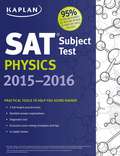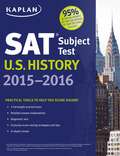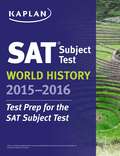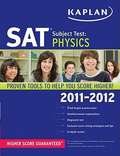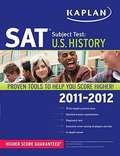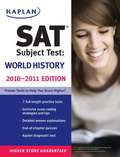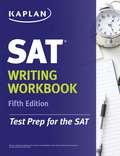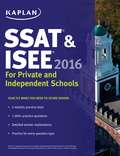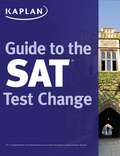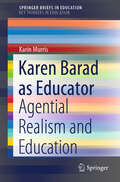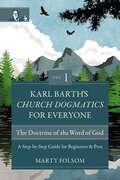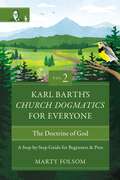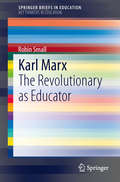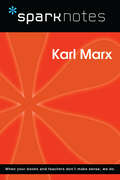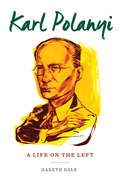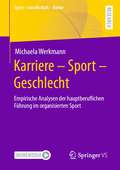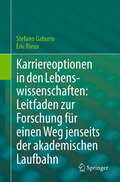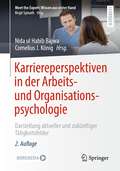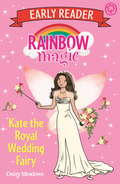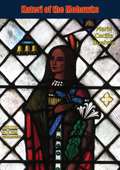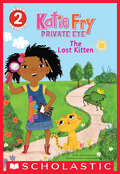- Table View
- List View
Kaplan SAT Subject Test Physics 2015-2016
by KaplanEssential strategies, practice, and review to ace the SAT Subject Test PhysicsGetting into a top college has never been more difficult. Students need to distinguish themselves from the crowd, and scoring well on a SAT Subject Test gives students a competitive edge. Kaplan's SAT Subject Test: Physics is the most up-to-date guide on the market with complete coverage of both the content review and strategies students need for success on test day.Kaplan's SAT Subject Test: Physics features:* A full-length diagnostic test* Full-length practice tests* Focused chapter summaries, highlights, and quizzes* Detailed answer explanations* Proven score-raising strategies* End-of-chapter quizzesKaplan is serious about raising students' scores--we guarantee students will get a higher score.
Kaplan SAT Subject Test U.S. History 2015-2016
by KaplanProven strategies, practice, and review to ace the SAT Subject Test U.S. History.Getting into a top college has never been more difficult. Students need to distinguish themselves from the crowd, and scoring well on a SAT Subject Test gives students a competitive edge. Kaplan's SAT Subject Test: U.S. History is the most up-to-date guide on the market with complete coverage of both the content review and strategies students need for success on test day.Kaplan's SAT Subject Test: U.S. History features:* A full-length diagnostic test* Full-length practice tests* Focused chapter summaries, highlights, and quizzes* Detailed answer explanations* Proven score-raising strategies* End-of-chapter quizzesKaplan is serious about raising students' scores--we guarantee students will get a higher score.
Kaplan SAT Subject Test World History 2015-2016
by KaplanProven strategies, practice, and review to ace the SAT Subject Test World History.Getting into a top college has never been more difficult. Students need to distinguish themselves from the crowd, and scoring well on a SAT Subject test gives students a competitive edge. Kaplan's SAT Subject Test: World History is the most up-to-date guide on the market with complete coverage of both the content review and strategies students need for success on test day.Kaplan's SAT Subject Test: World History features:* A full-length diagnostic test* Full-length practice tests* Focused chapter summaries, highlights, and quizzes* Detailed answer explanations* Proven score-raising strategies* End-of-chapter quizzesKaplan is serious about raising students' scores--we guarantee students will get a higher score.
Kaplan SAT Subject Test: Physics 2011-2012
by Hugh HendersonKaplan SAT Subject Test: Physics features: A full-length diagnostic test and practice tests, Focused chapter summaries, highlights, and quizzes, Detailed answer explanations, Proven score-raising strategies and End-of-chapter quizzes. The book is the most up-to-date guide with complete coverage of both the content review and strategies students need for success on test day.
Kaplan SAT Subject Test: U.S. History 2011-2012
by Mark Willner Joann Peters Eugene V. Resnick Jeff SchneiderThis book is designed to help high school students understand their SAT U.S. history test.
Kaplan SAT Subject Test: World History 2010-2011
by Peggy J. MartinKaplan SAT Subject Tests offer the most up-to-date and complete coverage of both content review and strategy needed to achieve a high score on these challenging exams, which can be used for college credit at many schools. Each book contains a Kaplan diagnostic test, full-length practice tests, chapter quizzes, score-raising tips, and detailed answer explanations. Also included is a special section with details and advice on the new SAT score-reporting changes. Kaplan's Higher Score Guarantee gives students a significant edge during these competitive times. With focused content review, proven strategies for scoring higher, and comprehensive test practice, Kaplan SAT Subject Tests get students ready for test day. Kaplan SAT Subject Test: Physicsincludes: 3 full-length Physics practice tests A full-length diagnostic test Focused chapter summaries, highlights, and quizzes Detailed answer explanations Proven score-raising strategies
Kaplan SAT Writing Workbook
by KaplanPrep for the current SAT with confidence. This SAT prep was designed for the current SAT and is good until the College Board's last official SAT administration in January 2016.Kaplan's SAT Writing Workbook is the complete test preparation tool that contains strategies, practice, and review for students who want to sharpen their writing skills for the SAT! No other products on the market can match the quality and experience behind Kaplan's SAT guides.SAT Writing Workbook includes in-depth coverage of all pertinent SAT writing information as well as effective score-raising strategies for building speed and accuracy from SAT writing experts. Not only does this tool contain everything a student needs to conquer the Writing section of the exam, it also provides key information about the SAT in general, such as Kaplan's methods for answering multiple-choice questions and more.Kaplan's SAT Writing Workbook contains many essential and unique features to help improve test scores, including:* Three realistic writing tests with detailed answer explanations covering all parts of the SAT Writing section* Effective score-raising methods and strategies for building speed and accuracy* Tips for tackling all writing question types from SAT experts* A comprehensive glossaryKaplan's SAT Writing Workbook provides students with everything they need to improve their scores--guaranteed. Kaplan's Higher Score guarantee provides security that no other test preparation guide on the market can match. Kaplan has helped more than three million students to prepare for standardized tests. We know that our test-taking techniques and strategies work and our materials are completely up-to-date. Kaplan's SAT Writing Workbook is the must-have preparation tool for every student looking to score higher!
Kaplan SSAT & ISEE 2016: For Private and Independent School Admissions
by KaplanEvery year, nearly 100,000 students take the Secondary School Admission Test (SSAT) or the Independent School Entrance Examination (ISEE) in order to gain admission to a top private school. Kaplan SSAT & ISEE 2016 provides the perfect mix of strategy and review for students looking to ace these important exams. This comprehensive study guide provides students with all of the resources they need for test day preparation, and gives parents advice on how to help their children navigate what can be a daunting experience for first-time test takers. Kaplan's SSAT & ISEE 2016 also includes: * Six full-length practice tests--three SSATs and three ISEEs--tailored to upper, middle, and lower grade levels* Detailed answer explanations* Hundreds of practice questions covering the most frequently tested material * Intensive, test-specific math and verbal workouts* Customized review sections for important subject areas, including verbal reasoning, mathematics, reading comprehension, and writing* Practical tips for every question type * Proven test-taking strategies to help students score higher
Kaplan's Guide to the SAT Test Change
by KaplanThe guide to the 2016 SAT test changes, from the test prep leader for 75 years! The College Board -- maker of the SAT -- has announced sweeping changes to the SAT and PSAT. Kaplan's Guide to the SAT Test Change explains what you need to know about the new test, and how you can begin to prepare for the upcoming SAT in 2016. This interactive guide is filled with innovative features and helpful information, including:* What is changing with the SAT* Specific guides for the classes of 2014, 2015, 2016, and 2017+* Links to free Kaplan resources to help you prep smarter, not harder* Links to free Kaplan resources to help you apply to college* Answers to Frequently Asked QuestionsKaplan's Guide to the SAT Test Change is a source of information not only about the upcoming changes to the SAT, but also about college admissions and standardized testing in general. Which tests should you take? What's the deal with the PSAT? What should you think about and when? These questions and more are answered in this guide.
Karen Barad as Educator: Agential Realism and Education (SpringerBriefs in Education)
by Karin MurrisThis book is about becoming touched and moved by Karen Barad’s agential realism. Karen Barad as Educator is not biographical. It is not about Barad. There is much to be learned about teaching and education research through the human and other-than-human narrative characters in Barad’s writings and way of life. Reading this book is about becoming entangled with, and being inspired by, a passionate yearning for a radical reconfiguration of education in all its settings and phases (e.g., day-care centres, schools, colleges, universities, but also homes, museums or therapy rooms). This book will appeal to lecturers, teachers, artists, therapists, parents and grandparents, funders of education research, organisers of educational events, as well as detached youth workers. In short, this book will speak to anyone interested in the ‘what’ and the ‘how’ of educational encounters and who is interested in alternatives to the dominant neoliberal national curricula, educational policies and humanist teaching, research, and conference agendas. The book aims to offer a gripping account for educators to be inspired by the invigorating and elusive philosophy of agential realism with a specific focus on iterative performative practices that profoundly matter to what counts as knowledge, teaching, learning and response-able education science.
Karl Barth's Church Dogmatics for Everyone, Volume 1---The Doctrine of the Word of God: A Step-by-Step Guide for Beginners and Pros (Karl Barth’s Church Dogmatics for Everyone)
by Marty FolsomA Guided Tour of One of the Greatest Theological Works of the Twentieth CenturyKarl Barth's Church Dogmatics is considered by many to be the most important theological work of the twentieth century and for many people reading it, or at least understanding its contents and arguments, is a lifelong goal. Yet its enormous size, at over 12,000 pages (in English translations) and enough print volumes to fill an entire shelf, make reading it a daunting prospect for seasoned theologians and novices alike.Karl Barth's Church Dogmatics for Everyone, Volume 1--The Doctrine of the Word of God helps bridge the gap for would-be Karl Barth readers from beginners to professionals by offering an introduction to Barth's theology and thought like no other. User-friendly and creative, this guide helps readers get the gist, significance, and relevance of what Barth intended for the church... to restore the focus of theology and revitalize the practices of the church.Each section contains insights for pastors, new theologians, professionals, and ordinary people including:Summaries of the sectionContextual considerationsAnd other visually informative features that reinforce the main points of the Barth's thoughtIn addition, each volume features the voices of authors from different academic disciplines who contribute brief reflections on the value of Church Dogmatics for creative discovery in their disciplines. Volume 1 reflections include:Douglas Campbell (biblical studies)Myk Habets (systematic theology)Richard Keith (pastors)Julie Canlis (ordinary people)James Chaousis (mental health)John Vissers (spiritual formation)Whether you are just discovering Barth or want a fresh look at his magnum opus, this series invites you to an enjoyable and insightful journey into the Church Dogmatics.
Karl Barth's Church Dogmatics for Everyone, Volume 2---The Doctrine of God: A Step-by-Step Guide for Beginners and Pros (Karl Barth’s Church Dogmatics for Everyone)
by Marty FolsomA Guided Tour of One of the Greatest Theological Works of the Twentieth CenturyKarl Barth's?Church Dogmatics?is considered by many to be the most important theological work of the twentieth century. For many people, reading it and understanding its arguments is a lifelong goal. Its enormous size, at over 12,000 pages (in English translations) and enough print volumes to fill an entire shelf, make reading it a daunting prospect.Karl Barth's Church Dogmatics for Everyone, Volume 2--The Doctrine of God helps bridge the gap for Karl Barth readers from beginners to professionals by offering an introduction to Barth's theology and thought like no other. User-friendly and creative, this guide helps readers get the gist, significance, and relevance of what Barth intended for the church... to restore the focus of theology and revitalize the practices of the church.Each section contains insights for pastors, new theologians, professionals, and ordinary people including:Summaries of the sectionContextual considerationsAnd other visually informative features that reinforce the main points of the Barth's thought In addition, each volume features the voices of authors from different academic disciplines who contribute brief reflections on the value of Church Dogmatics for creative discovery in their disciplines. Volume 2 reflections include:Chris Tilling (biblical studies)David Guretzki (systematic theology)Earl Palmer (pastors)Wyatt Houtz (ordinary people)Andrew Howie (mental health)James Houston (spiritual formation)Ross Hastings (science)Jeremy Begbie (the arts)Whether you are just discovering Barth or want a fresh look at his magnum opus, this series invites you to an enjoyable and insightful journey into the Church Dogmatics.
Karl Marx
by Robin SmallThis book is an introduction to Karl Marx (1818-1883) as a radical educational thinker. Marx's own schooling and education are examined and we see how his interest in educational issues was informed by his own experience. Educational themes in Marx's thinking are identified: the role of education within capitalist society, the contribution of education to human development and the character of education in a future society. These are placed in a historical setting by the author and related to public debates over educational policy. Throughout his career, Marx identified education as key to the prospects of the working class. The story of this engagement adds a new dimension to the picture of his work as a philosopher, political economist and socialist revolutionary. The aspects of education that concerned Marx matched prominent features of his theoretical and political activity, and educational themes provided him with a critical application for many of his most important ideas. The author explores Marx's work on the British factory school system, his use of evidence from the reports of school inspectors, and the contemporary movement that led to the establishment of modern systems of public schooling. The final chapter relates Marx's thinking to questions about the place of education in today's society, showing how relevant it is for the twenty-first century. These discussions contain new scholarship, draw on original sources and are written in a clear and readable style. Students in education courses at universities and colleges, educational researchers and teachers will find this examination of Karl Marx's ideas concerning education both engaging and enlightening.
Karl Marx (SparkNotes Philosophy Guide)
by SparkNotesKarl Marx (SparkNotes Philosophy Guide) Making the reading experience fun! SparkNotes Philosophy Guides are one-stop guides to the great works of philosophy–masterpieces that stand at the foundations of Western thought. Inside each Philosophy Guide you&’ll find insightful overviews of great philosophical works of the Western world.
Karl Polanyi: A Life on the Left (Key Contemporary Thinkers)
by Gareth DaleKarl Polanyi (1886–1964) was one of the twentieth century's most original interpreters of the market economy. His penetrating analysis of globalization's disruptions and the Great Depression's underlying causes still serves as an effective counterargument to free market fundamentalism. This biography shows how the major personal and historical events of his life transformed him from a bourgeois radical into a Christian socialist but also informed his ambivalent stance on social democracy, communism, the New Deal, and the shifting intellectual scene of postwar America.The book begins with Polanyi's childhood in the Habsburg Empire and his involvement with the Great War and Hungary's postwar revolution. It connects Polanyi's idealistic radicalism to the political promise and intellectual ferment of Red Vienna and the horror of fascism. The narrative revisits Polanyi's oeuvre in English, German, and Hungarian, includes exhaustive research in five archives, and features interviews with Polanyi's daughter, students, and colleagues, clarifying the contradictory aspects of the thinker's work. These personal accounts also shed light on Polanyi's connections to scholars, Christians, atheists, journalists, hot and cold warriors, and socialists of all stripes. Karl Polanyi: A Life on the Left engages with Polanyi's biography as a reflection and condensation of extraordinary times. It highlights the historical ruptures, tensions, and upheavals that the thinker sought to capture and comprehend and, in telling his story, engages with the intellectual and political history of a turbulent epoch.
Karnataka Grama Swaraj mattu Panchayath Raj Adhiniyama, 1993: ಕರ್ನಾಟಕ ಗ್ರಾಮ ಸ್ವರಾಜ್ ಮತ್ತು ಪಂಚಾಯತ್ ರಾಜ್ ಅಧಿನಿಯಮ, 1993
by Sathpal Pulaniಈ ಪುಸ್ತಕವು ಕರ್ನಾಟಕ ಗ್ರಾಮ ಸ್ವರಾಜ್ ಮತ್ತು ಪಂಚಾಯತ್ ರಾಜ್ ಅಧಿನಿಯಮ, 1993 ಗ್ರಾಮ ಪಂಚಾಯತ್ ಪಿ.ಡಿ.ಓ. ಮತ್ತು ಸ್.ಡಿ.ಎ ಸ್ಪರ್ಧಾತ್ಮಕ ಪರೀಕ್ಷೆಗಳ ಹುದ್ದೆಗಳಿಗಾಗಿ ಸರಳವಾದ ಸಂಕ್ಷಿಪ್ತ ಕೈಪಿಡಿಯಾಗಿದೆ.
Karnataka Itihasa BA 5th Semester: ಕರ್ನಾಟಕ ಇತಿಹಾಸ ಬಿ.ಎ 5ನೇ ಸೆಮಿಸ್ಟರ್
by Friends Comminications Ballariಇದು ಕರ್ನಾಟಕ ಇತಿಹಾಸ ಶ್ರೀ ಕೃಷ್ಣದೇವರಾಯ ವಿಶ್ವವಿದ್ಯಾಲಯದ ಬಿ.ಎ 5ನೇ ಸೆಮಿಸ್ಟರ್ ಕರ್ನಾಟಕ ಮೂಲದ ಸಾಮ್ರಾಜ್ಯಗಳ ಪ್ರಭಾವ ಭಾರತದ ಎಲ್ಲ ಭಾಗಗಳಲ್ಲೂ ಕಂಡು ಬರುತ್ತದೆ, ಇದು ಕನ್ನಡ ಮಾಧ್ಯಮದ ವಿದ್ಯಾರ್ಥಿಗಳಿಗೆ ಈ ಪುಸ್ತಕವು ಉಪಯುಕ್ತವಾಗಿದೆ.
Karnataka Rajakeeya Itihasa mattu Karnataka Samskruthika Parampare Patrike-1 & 2 BA 2nd Semester: ಕರ್ನಾಟಕ ರಾಜಕೀಯ ಇತಿಹಾಸ ಮತ್ತು ಕರ್ನಾಟಕ ಸಾಂಸ್ಕೃತಿಕ ಪರಂಪರೆ ಪತ್ರಿಕೆ-1 ಮತ್ತು 2 ಬಿ. ಎ ದ್ವಿತೀಯ ಸೆಮಿಸ್ಟರ್
by Dr K Jagadeeshಇದು ಅಖಿಲ ಕರ್ನಾಟಕ ವಿಶ್ವವಿದ್ಯಾಲಯಗಳಿಂದ ಕರ್ನಾಟಕ ರಾಜಕೀಯ ಇತಿಹಾಸ ಮತ್ತು ಕರ್ನಾಟಕ ಸಾಂಸ್ಕೃತಿಕ ಪರಂಪರೆ ಪತ್ರಿಕೆ-1 ಮತ್ತು 2 ಬಿ. ಎ ದ್ವಿತೀಯ ಸೆಮಿಸ್ಟರ್ ಕನ್ನಡ ಮಾಧ್ಯಮ ಶೈಕ್ಷಣಿಕ ಪಠ್ಯ ಪುಸ್ತಕವಾಗಿದೆ.
Karriere – Sport – Geschlecht: Empirische Analysen der hauptberuflichen Führung im organisierten Sport (Sport – Gesellschaft – Kultur)
by Michaela WerkmannIn den, traditionell ehrenamtlich geprägten, deutschen Sportverbänden lässt sich eine zunehmende Einflussnahme und Entscheidungskompetenz des hauptberuflichen Führungspersonals beobachten. Eine wissenschaftliche Auseinandersetzung mit diesen „neuen“ Personalstrukturen und AkteurInnen fehlt jedoch weitestgehend. Ebenso ist die Frage der geschlechtergerechten Teilhabe an diesem Personalbereich empirisch unbeantwortet. An diese Forschungsdesiderate anknüpfend wird auf Basis eines mehrperspektivischen Theoriezugangs aus Ansätzen der Professionalisierungs-, Karriere- und Geschlechterforschung sowie eines multimethodischen Forschungsdesigns den Fragestellungen nachgegangen: 1. Wodurch zeichnen sich hauptberufliche Personalstrukturen und Karrieren von Führungskräften im organisierten Sport aus? 2. Wird bei den hauptberuflichen Personalstrukturen und Karrieren von Führungskräften im organisierten Sport Geschlecht zu einer bedeutsamen Ordnungskategorie? Wie lassen sich Prozesse und Strukturen der Relevanzwerdung von Geschlecht beschreiben und erklären? Die Autorin Michaela Werkmann ist Postdoktorandin im Arbeitsbereich Sportpädagogik des Instituts für Sport und Sportwissenschaft der Universität Freiburg. Ihre Schwerpunkte in Forschung und Lehre liegen in der sportbezogenen Geschlechter- und Diversitätsforschung, insb. in den Themenbereichen Soziale Konstruktion von Geschlecht im Sport, Karrieren und Führung in Sportorganisationen, Teilhabe am Sport und Sport(organisations)entwicklung.
Karriereoptionen in den Lebenswissenschaften: Leitfaden zur Forschung für einen Weg jenseits der akademischen Laufbahn
by Stefano Gaburro Eric RieuxDieser praktische Leitfaden zeigt alternative Karrieremöglichkeiten für Forscher in den Lebenswissenschaften jenseits der akademischen Laufbahn auf. Verfasst von aktiven Fachleuten mit praktischer Erfahrung bietet das Buch einen umfassenden Überblick über nicht-akademische Rollen und die vielen verfügbaren Karrierewege. In unserer Ausbildung in den Lebenswissenschaften durchlaufen viele von uns eine klassische akademische Ausbildung, die uns auf die Durchführung von universitärer Forschung vorbereitet. Allerdings landen nur 20-30 % der Studierenden in festen akademischen Positionen. Der Rest verlässt das Feld aufgrund der herausfordernden Bedingungen und fehlender gesicherter Anstellung. Da sich das Gebiet weiterhin ausdehnt und diversifiziert, wachsen auch die Chancen für die berufliche Entwicklung außerhalb der traditionellen Wege. Es gibt eine steigende Nachfrage nach qualifizierten Experten, um verschiedene Stellen in der Industrie, der Regierung und anderen Sektoren zu besetzen. Hier finden Sie Anleitungen, wie Sie Ihre wissenschaftliche Erfahrung optimal nutzen können, um in den verschiedenen Rollen erfolgreich zu sein. Darüber hinaus wird die Vorbereitung Ihres Lebenslaufs (CV), Anschreibens und Ihrer sozialen Medien (LinkedIn) behandelt. Interviews mit ausgewählten Persönlichkeiten aus verschiedenen Bereichen bieten einzigartige Einblicke in Lebenswege mit echtem praktischem Bezug. Schließlich berät dieses Werk Universitäten und akademische Einrichtungen, wie ein entsprechendes Bildungsmodell in ihre Lehrpläne integriert werden könnte, um zukünftigen Absolventen der Lebenswissenschaften ein umfassendes Spektrum ihrer Möglichkeiten zu bieten.
Karriereperspektiven in der Arbeits- und Organisationspsychologie: Darstellung aktueller und zukünftiger Tätigkeitsfelder (Meet the Expert: Wissen aus erster Hand)
by Nida ul Habib Bajwa Cornelius J. KönigDieses Buch bietet Studienanfängern sowie Abiturienten, die sich für die Arbeits- und Organisationspsychologie interessieren, Einblicke in die vielfältigen Berufsfelder des Fachgebiets. Die Arbeits- und Organisationspsychologie hat sich in den letzten Jahrzehnten in Deutschland sehr gut etabliert, sowohl innerhalb der Psychologie als auch in der Wirtschaft. Es ist nach der klinischen Psychologie das zweitwichtigste Anwendungsfach der Psychologie. So richten sich über 30% aller ausgeschriebenen Arbeitsstellen für Psychologen an Psychologie-Absolventen mit einem Schwerpunkt in der Arbeits- und Organisationspsychologie. Experten aus der Praxis stellen in diesem Band sehr anschaulich Ihren Berufsalltag dar, schildern ihre persönlichen Werdegänge und zeigen mögliche Karriereperspektiven für angehende Arbeits-, Organisations- und Wirtschaftspsychologen auf. Dadurch gibt dieses Werk eine wertvolle Orientierung und erleichtert den Entscheidungsprozess. Kurze Video-Clips aus den Experteninterviews bereichern den Inhalt durch zusätzlichen Nutzen.
Karyalaya Vyavasthapan Second Semester FYB.COM New NEP Syllabus - RTMNU: कार्यालय व्यवस्थापन दुसरे सत्र एफ.वाय.बी.कॉम. नवीन एन.इ.पी. अभ्यासक्रम - राष्ट्रसंत तुकडोजी महाराज नागपूर विद्यापीठ
by Dr Jyoti R. Tarhane Atul G. Kapgate‘कार्यालय व्यवस्थापन’ हे पुस्तक बी.कॉम. (प्रथम वर्ष, दुसरे सत्र) अभ्यासक्रमासाठी तयार करण्यात आले आहे. आधुनिक कार्यालयीन व्यवस्थापनाचे मूलतत्त्व, कार्यालयीन संवाद, मार्गदर्शिका व अहवाल लेखन, तसेच कार्यालयीन बैठका या महत्त्वाच्या घटकांवर हे पुस्तक सविस्तर मार्गदर्शन करते. यामध्ये नियोजन, आयोजन, कर्मचारी व्यवस्थापन, संप्रेषण कौशल्ये, आर्थिक नियोजन, आणि आधुनिक ऑफिस मॅनेजरसमोरील आव्हानांचा उहापोह केला आहे. विद्यार्थ्यांना सैद्धांतिक तसेच प्रात्यक्षिक दृष्टीने कार्यालय व्यवस्थापन समजून घेण्यास हे पुस्तक उपयुक्त ठरते.
Kate the Royal Wedding Fairy (Rainbow Magic Early Reader #14)
by Daisy MeadowsThese cheerful and inviting Early Readers bring the blast of colour that Rainbow Magic's youngest fans have been waiting for!Kate the Royal Wedding Fairy makes sure that all weddings are happy and magical! But when mean Jack Frost steals the True Love Crown, the Fairyland royal wedding is sure to be a disaster. Can Kirsty and Rachel find the crown so the royal couple will live happily ever after...?'These stories are magic; they turn children into readers!' ReadingZone.comIf you like Rainbow Magic, check out Daisy Meadows' other series: Magic Animal Friends and Unicorn Magic!
Kateri of the Mohawks
by Marie BuehrleFROM SAVAGE TO SAINTFirst published in 1954, this book tells the story of a Mohawk chieftain’s daughter who may soon may be canonized as North America’s first native saint.THE daughter of a Mohawk chieftain, Kateri Tekakwitha was born in 1656. Her mother, an Algonquin Christian captured in a Mohawk raid, was the brief but enduring influence in Tekakwitha’s life. Whatever chance she may have had to teach her child about Christianity was lost when both parents died in a smallpox epidemic.Tekakwitha was ten years old when she heard for the first time of Rawenniio, the white man’s God. But a full ten years passed before a Blackrobe, the Jesuit Father James de Lamberville, baptized her on Easter Sunday, 1676.She practiced her new faith with ever increasing fervor. After fleeing to the mission settlement in Canada, where she could join other Christians in the undisturbed practice of their faith, she performed extreme penances.Through a close companion, Kateri’s words have been preserved for us, revealing the spirit of love and atonement with which she entered into this voluntary mortification. Soon her spent body could no longer contain her soaring soul. She died at the age of twenty-four, leaving all near her convinced that they were witnessing the passing of a saint.
Katie Fry, Private Eye: The Lost Kitten (Scholastic Reader, Level 2)
by Katherine CoxA great introduction to simple, fun mysteries for beginning readers!Katie Fry may be little, but she's got a big brain, and she uses it to solve mysteries. So when she finds a very cute, VERY lost kitten named Sherlock, she decides to take his case. Can Katie track down the clues to find Sherlock's home?Beginning readers will love hunting for clues in the art right along with Katie and Sherlock!
